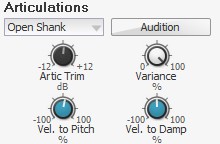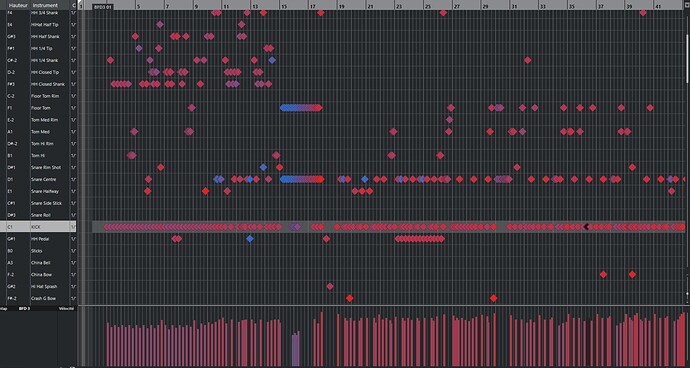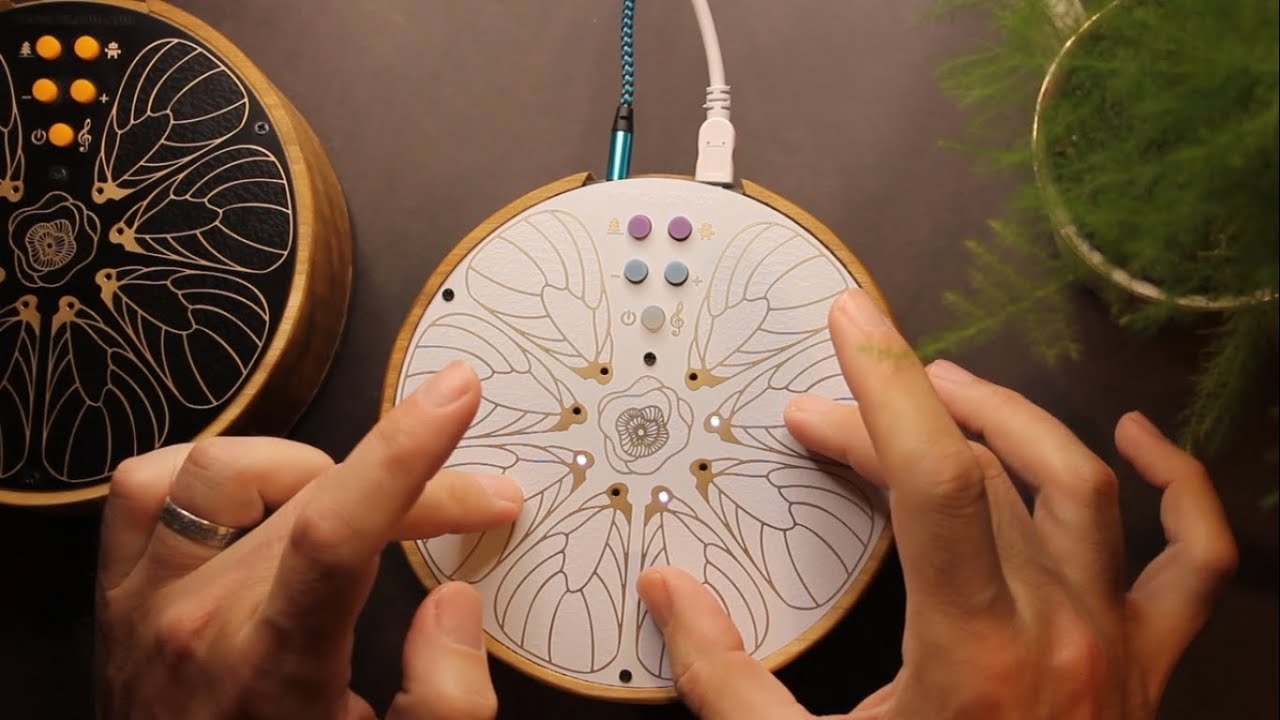Hey BFD people. By curiosity and in order to make a topic that is not complaining about glitches, I thought about sharing what I do for making a midi drum performance sound like it was actually played and recorded live.
It’s a really complex matter and I’ll try to be clear on my thoughts and I’ll try to separate subjects.
Of course, we all (should) know about quantification and how, unless it’s wanted, every notes must not be perfectly aligned to the grid. We also know about velocity and its importance in making dynamics. But there is more to that. Here is a few tips that I’m thinking right now, I may add some later.
About DYNAMICS and PLACEMENT :
- Don’t hesitate to play with all of your drum element’s articulations. All of the hi-hat openings (closed tip/shank, open shank 2/4, bell, splashing…), snare’s hits (rimshot, edge, drag…), crash’s sides (edge, bow, bell). Try to put some small “mistakes” like a hit on snare that is not centered (edge hit), if you’re messing with your ride bell, sometimes you can miss the bell and hit the edge… During a fast fill, it can happen to hit the tom edge (rimshot), or hit a crash’s bow instead of hitting it fully (edge).
Put some ghost notes : light snare hits that drummer often do, it is not always intended to be heard, but they should be perceived. It adds groove and dynamics. If you want an example of with and without ghost notes, listen to this : Stream Ghost Notes Comparison by Autumn | Listen online for free on SoundCloud - Think about placement : if you go from left to right during a fill, you may be a bit late when going all the way back to the left if the time is short. So you may not we precisely on time at the end of your fill, and that’s where random quantification has its limits : manually delay your notes a bit. Sometimes, manually put them before the grid if the drummer may accelerate. It is not always mistakes, drummers may purposely rush or drag the rythm by playing with the tempo in order to create a sensation of urge or heaviness. The grid should be viewed as a TOOL. Don’t think about how you need to adapt your song to it, but how it can help you stay on the rythm and play with it to make some groove !
- Think GLOBALLY and with PARTS for the velocities. For rock songs, the average velocity during verses may be around ~100. During choruses it can be around 115. Save 120-127 for the climax or the very accentuated parts. If the song has a relaxed part, go lower, like 70-90. [Just examples, it may vary between drum samples and softwares]. Your velocities have to make “waves” during the whole song : the first chorus may be not as powerful as the last chorus. Chill down from a part to an other, play just a bit harder during fills and transitions, if verses and choruses are similars, change an articulation, the overall velocity dynamic or just for a few hits.
Of course, during live recordings, engineer often copy and paste parts that are played multiple times like a chorus so it’s not a big deal. But if you want to preserve or, in this case, recreate dynamic in your song, make waves.
Yes, a good drummer is consistent, but he also needs to know how to play with dynamics… He also needs to play what will serve the song right so it’s your call on that
The thing is to make variations in order to not sound boring and predictable. We’re humans, not machine. We make mistakes. Music is about feeling and a real drummer won’t be playing at the same range during the whole song. But don’t overdo it and make it sound like you have a sloppy and inconsistent drummer…
Here’s how your notes and velocity ranges should look like :
Of course I’m talking here about the diversity and dynamics. Not the intensity of the velocity that is up to your song, the drum samples used and your type of music !!
Now, what you can also do through BFD3 to help you create diversity and realism.
- Use and adjust the AMG (anti machine-gun) device from BFD3. It helps by using round robins (alternative samples for the same element at the same velocity) and offer tonal and volume variations. It is activated by default. However I noticed that it can sometimes create problem, mostly with volume variations during fast open-closed hi-hat rythms : don’t hesitate to reduce the value. Now, I’m not really familiar with the AMG tweaks so don’t hesitate to add things or correct me.
Some other VSTI offer pitch random variation, like Studio Drummer. That’s a really great feature, but I can’t find it on BFD except the pitch variation through velocity. - Speaking about that… The velocity to pitch knob :

You can use it on all articulations or select the one you want to affect. You can then choose to add a higher or lower pitch based on the velocity you are using. By adding just a little amount you can create a sound change when hitting hard, added to the impact of the high velocity. I found it really useful on some hi-hat articulations. Don’t hesitate to also add some db for some articulations that may sound weak compared to the rest, like the “Open Tip” that is often weaker to the others, on many BFD3 hi-hats.
Here is a sound test from a 0% to 5% then 9% pitch change (higher) for the open shank articulation :
Stream PitchVelocity by Autumn | Listen online for free on SoundCloud.
Don’t overuse it unless for creative purposes !
- There is a way to force a “random” pitch modification as it seems there is none in BFD3.
Duplicate your snare but modify it. Currently, snare microphones are glitched when you want to do some layering (use multiple snares), mic channels are not fully displayed. But you can still try it.
If you’re using, let’s say a Tama Bell Brass snare, add the same one with the same mixer settings, don’t link it but assign it other midi inputs. Change the tune just slightly higher or lower than your main one.
Swap some of your midi notes from your main snare to the duplicate one. You now have infinite round-robin likes ! It creates more hits that don’t sound like the others and add realism. Feel free to tweak other things in the duplicated snare : add a slim EQ to change the tone, for example. - If you feel the drums are sounding too clean, unlike BFD2 library, add some saturation on it to recreate natural artifacts to your sound that a recorded drum kit would have.
Finally, one last thing, check if your DAW can show a drum map. Drum maps are like what is shown in the BFD3’s groove editor, it names the drum element linked to the midi note, instead of a simple piano roll.
I know that Cubase has it through the “rythm editor” that can load drum maps. You can see how I renamed everything in accordance with the articulations, on my screen above. I say that because I know a lot of people that are placing midi notes just by ear, and when they send me the midi file I notice that they put all snare hits on the edge, and use wrong articulations. It also forces you to use all articulations because you can see clearly what you have and where they are.
I’m sure that there is still many ways to improve, but here is some examples of rock drum tracks that I created on BFD3 based on some of these tips.
Here is the first and most recent one including all the tips mentionned except for the saturation. There is no effect but a limiter on the master channel. Stream Drum track 2 by Autumn | Listen online for free on SoundCloud
An older drum only track with FX off : Stream Tutonofx by Autumn | Listen online for free on SoundCloud Yes I know, the volumes are not balanced, I did not have the time to adjust the channels 
Here is the same last track with a bit of amateur mixing and the other instruments : Stream Tuto Full No Voice by Autumn | Listen online for free on SoundCloud
Of course, the average listener won’t notice all of the details you spent your time on. They won’t notice that the drummer hit the bow and not the edge of the crash at 2:32 during the chorus, while listening to your track through a compressed youtube video and during a party with everyone talking on the back. But they will FEEL the humanity of your track, even unconsciously. Drum and bass quality is more important than guitars, but a lot of producers take more time working guitar sounds than the drum or the bass.
If you want to stand out and can’t afford to record real drums, take the time and work your midi tracks, mostly when you have the chance of having a great software like BFD3.
Now, I’m just an amateur but I spent a lot of time understanding midi drums and reading guides, and some of these tips are never mentioned so I thought I’d give it a go, while skipping the most basic tips that I may add later, with other ones. I’m also open to new tips and approaches, I’m eager to hear your take on all of that ! 






